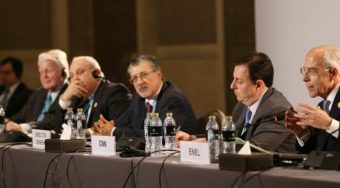 Renewable energy, for three years running, has accounted for more new power generation capacity installed worldwide than all other sources combined. In 2015, over USD 270 billion were invested in solar PV and wind power, boosting capacity by 47 GW 63 GW respectively. This capacity is expected to only grow and efforts are now focusing on implementing an innovative enabling framework to integrate these technologies at the scale needed. But that is not a simple task and questions still remain: what technologies and tool are part of the power sector transformation? What still needs to be developed? And how can IRENA assist?
Renewable energy, for three years running, has accounted for more new power generation capacity installed worldwide than all other sources combined. In 2015, over USD 270 billion were invested in solar PV and wind power, boosting capacity by 47 GW 63 GW respectively. This capacity is expected to only grow and efforts are now focusing on implementing an innovative enabling framework to integrate these technologies at the scale needed. But that is not a simple task and questions still remain: what technologies and tool are part of the power sector transformation? What still needs to be developed? And how can IRENA assist?
“The transformation of the energy sector towards a renewables-based one is moving forward at an accelerated pace. Nowhere is this revolution more evident than in the power sector,” said Adnan Z. Amin, IRENA Director-General, at the opening Ministerial Roundtable, Towards an Economy Fuelled by Renewable Power: Innovation for the Next Stage of the Power Sector Transformation.
Government officials from around the world gathered to discuss the ongoing power sector transformation, and converse with prominent executives from the energy industry on its future development and outlook.
Integrating high shares of variable renewable energy in power systems, is a challenge not only from the perspective of securing the power supply, but also from the perspective of how to manage the surplus power from these sources.
In some countries at certain times, variable renewable power generation exceeds demand. Windy days in Denmark can produce 116% of the domestic power demand, and a share as high as 140% was reached in July 2015. In Portugal, wind power produced up to 65% of domestic power demand on some days in December 2015. On 8 May 2016, 95% of Germany’s domestic power demand was supplied by solar PV and wind power, and exports of electricity surged.
Energy experts and country representatives agreed that a holistic innovation approach is needed to tackle this challenge. Innovations ranging from technology to market design and business models all have a role to play. Part of the solution lies in implementing innovative flexibility measures in the power system, including additional cross-border interconnections, electricity storage systems, demand side management strategies, and advanced weather forecasting.
Luiz Barroso President of Brazil’s Energy Research Company, explained the country’s use of renewable energy auctions and biofuels, and highlighted how hydro and renewables can be used to leverage both technologies, something recently explored in IRENA’s market analysis of Latin America.
Barroso highlighted that although financing is available, risk allocation and business models are everything to tap these resources. “We like renewables because their short construction time is a hedge against economic uncertainty,” he told the Ministerial Roundtable, while explaining that currency risk can be an issue in emerging economies.
The outcomes of the Ministerial Roundtable was reported back to the Assembly, and will further feed into IRENA work, particularly IRENA’s two alternating biennial activities regarding the power sector transformation; the IRENA Innovation Week, which was last held in 2016; and the Innovation landscape report for the power sector transformation, which is expected to come out later this year. They will highlight not only technological innovations, but the market, regulatory, and business model changes that are making the up-scaling of variable renewables possible.
To learn more about innovation, check out IRENA’s innovation outlook reports on offshore wind power, advanced liquid biofuels, and renewable mini-grids.
Source: irenanewsroom.org


